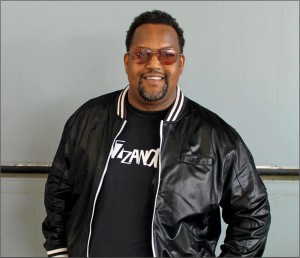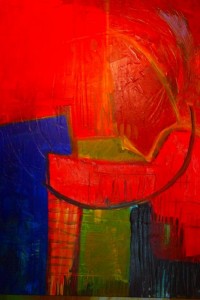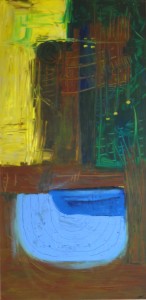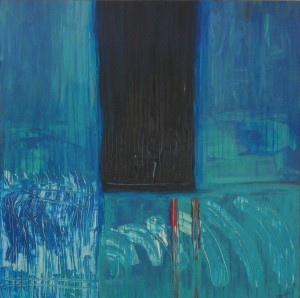See more of James’s art at: James McKissic
For interviews with other painters see: Ellyn Bivin / Josiah Golson / David Jones / Renel Plouffe / James Tucker / Larry Young
Born in Cleveland, Tennessee, James McKissic, currently Director of Multicultural Affairs for the City of Chattanooga, is a lifelong artist and art collector whose paintings draw upon and explore the African-American experience. His mother was a teacher and educational administrator before her retirement, and his father edited and published the Tennessee Informer until his death in 2003. After he graduated from the University of Tennessee-Chattanooga, James spent two years in AmeriCorps working in Atlanta, before attending the Wagner School of Public Service at New York University. After working in Connecticut for a few years, he returned to Chattanooga in 2003. During his time in the Northeast, James took painting and drawing classes whenever he could. Indeed, it was at the New Haven Artist Workshop that James came into his own as a painter, developing a new visual vocabulary that he has continued to expand. This résumé may not sound like that of most artists, but it was probably an inevitable path for James—his love of art runs deep, but public service features prominently across the generations of his family, many of who were teachers. It was necessary for him to follow both paths.
James, your paintings are large, powerful, and complex. How do you begin? What brings you to the point of starting a specific work?
Usually, by the time I get to the canvas I’ve spent a lot of time thinking about the form I want to begin with. I always begin with some sort of idea of how the larger shapes will fit together. That gives me the basic structure of the painting. As you know, a lot of my work is driven by cultural topics or by current events, and my feelings about the subject drive the work.
For instance, the painting I’m working on right now is derived from the culture of the African Diaspora, which resulted from Africans being taken from their native cultures and having to adapt their institutions and beliefs. When Africans were brought to the new world they often combined their deeply held traditional beliefs with the outward forms of Christianity. It would appear they were worshipping the approved god when really they were worshipping the gods of the old country.
The specific reference in my current painting is the feast day of Yemaja, which is part of Orisha worship. Orisha worship is a combination of Roman Catholic and African belief. This feast day honors one of the traditional goddesses, Yemaja, who is associated with water and with the feminine principle of creation. The celebration features watermelons, cantaloupes, and other fruits of that sort which are broken open along the banks of a river as an offering to honor her. In my painting, you see ovals and sensuous forms, but the meaning may not be immediately apparent to the viewer. There is, of course, a connection between the name of the painting and what the viewer sees, but a person walking up to the painting wouldn’t necessarily make that connection. I’ve worked through the subject emotionally and intellectually to find a visual means to express it.
But what makes your work seem so spontaneous and free?
(Laughs) Well, when I start painting, things become a lot more free-form. I usually work with the palate knife; actually I use a set of different palate knives. I mostly paint in acrylic. Sometimes I put things in the paint or onto a painted passage while it is wet. I might have a section of a painting that is nothing but thin washes of color with thicker paint built up around it.
I love the actual painting process but sometimes I can get too engrossed in a small section and have to force myself back to working on the whole canvas. It can be a battle. So one thing I’ve learned to do is to take time away from a painting, a few days, maybe more, and then I can see more connections, more visual connections, than I had seen at first.
You did layout work for your Dad’s newspaper when you were young. Does that experience influence how you construct your paintings?
Maybe a little. The arts were important in my family, and I saw good art as a child. Then I had a really exceptional high school art teacher, Martha Kidwell, and she worked hard with us on both the technical side, how to produce a painting, but also with art history and how to look and paintings and other kinds of art. She insisted that a well-constructed painting had to work visually no matter how it was held—upside down, sideways, or right side up. You know I was in France last year and went to the Louvre, and as I looked at the art I could hear her voice in my head, telling me how to process what I was seeing. She said that we would one day see great art like that, and I did. And I think there is another thing going on with how I see painting — I’m an artist , but also an art collector, and that gives me a different point of view, a different angle, from which to look at art.
What are the influences on your work?
Like many artists, I’ve struggled as I’ve matured to find, to create, my own style. Than can be more difficult, I think, when you’re an abstract painter. In the African-American community, abstract painters have always sort of been on the side, not really getting much recognition, but that, I think, is changing. African-American abstractionists are starting to be collected. There are some great abstract painters that I love and who deserve greater recognition—Norman Lewis, Howardina Pendall, Alma Thomas, and Art Smith, are a few that come to mind. But to answer your question, the African Diaspora has had a huge influence on me. That’s something I’ve read about and studied. But the most seminal time for my art was the time I spent in Cuba.
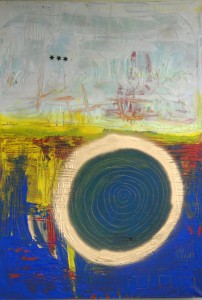
Meditation on the Triangle Trade
When were you in Cuba?
In 2001. I went with a special educational tour through my graduate school (NYU). We went to look at their educational system and healthcare system, but I was also soaking up the Cuban culture as well—the colors, the interiors of people’s homes, the old cars—let’s just say a lot of the images I found there were just emblazoned on my imagination. Travel has meant a lot to me. I also loved my time in Mexico City. I toured the mural collections, saw the Mayan pyramids, and visited Frida Khalo’s house. I particularly remember the blues I saw there.
However, to get back to the question of what drives my art, I’d have to say the major influence on me and my work is history, or more specifically, Black history. Not the political, ‘who did what in 1823’ history, I’m interested in how people survived through religion and folk beliefs, home remedies, and that sort of thing. People survived because they had a culture that passed from person to person, generation to generation. A lot of that stuff shows up in my work: symbols, color, recipes, etc. I’ve even done paintings based on love potions.
I know these sorts of things sound quaint or esoteric, but they are really part of my DNA. They were part of my childhood experiences. I had elderly great aunts who were careful to gather up the hair from their hairbrushes and who burned their fingernail clippings so those things couldn’t be used in spells against them. They would put different powders and salts at the doorway to ward off evil spirits. It was just part of their culture. They reached into the supernatural for protection. We’ve really lost all that in the modern world, but we are only a couple of generations removed from it.
And from my knowledge of history and culture, I’ve encountered various symbols I’ve found useful. For instance, I often use the shape of a Cowrie shell scratched or painted onto my canvases. The Cowrie shell is a small oval shell that some African cultures have used as currency. It sort of looks like and suggests a seed, which becomes a symbol of how people, like seeds blown by the wind, were scattered by the African Diaspora and took root in unexpected places. And further, if you look down on a Cowrie shell from directly above it, the striations on the shell and its shape suggest a slave ship to my eye. That’s just one example of a symbol I use, but the oval shape tends to be very important to me.
Do you plan your color before beginning a painting?
I do. I use a color wheel. I have an app on my I-pad that’s Josef Albers’s, “The Color Book”. With that app you can move the colors around with your hand and see what they look like beside each other. I think it’s fair to say that during the thinking and planning stage that goes on prior to starting a canvas, color definitely comes into things.
And your surfaces have a nice ‘juicy’ painterly feel.
Yes, and that’s very intentional. One of my mentors, Charlie Newton, told me, “You have to remember, James, people love paint. If they spend money on a painting they want to see paint!” I do a lot of building up layers of paint and scratching back through with the knife as a way of introducing interest and presenting the symbols important to my work. There’s a real physicality to painting for me. I like to paint while listening to music and sometimes the rhythms I’m reacting to can show up in my work.
What music do you listen to?
Classic jazz and a lot of African pop music, but never any that’s sung in English. I want to feel the sound but if I can understand the lyrics, I’ll focus on that and not on my painting. I also listen to a lot of Latin American music from the 1940s and 50s.
Where do you see your art going in the future?
I don’t know. I never worry about that. I don’t need to worry about being financially successful as an artist.
I paint because painting keeps me alive. When things happen in the world, things that have me inflamed, things like Trayvon Martin, painting gives me a place where I can meditate on it, explore it, try to come to some conclusions and maybe some resolution, and finally close the door on it and walk away. Painting for me is a survival mechanism. It’s not a path to fame or a way to make money. It’s like my drug. If I have a place to paint and a chance to show my work to people, then that’s enough. What more can you ask for?
Return to Interviews with Artists
